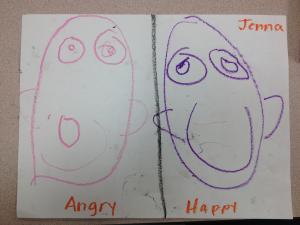Prep
Make a list of student pairs.
Set Up
Per pair of two students: 2 pieces of manila paper, selection of oil pastels
Introduction/ Warm-Up
1. Begin by having students name different feelings and emotions. Have students state the emotion and then express that emotion on their face for the group to see. Have students imitate the various emotions that are shared.
2. Introduce the still image of the video The Quintet of Remembrance. Explain that this video (image) shows people expressing different feelings.
3. Ask students to describe how they think the people are feeling in the image. Ask students to describe what the people’s faces are doing.
4. Tell the students that they are going to draw a face showing a feeling. Tell them they will work in pairs to draw a friend’s face expressing an emotion.
5. Model the process of drawing a face by using another adult or a student. Describe how the person is feeling as you are drawing; model correct placement of facial feature (eyes, ears, mouth, nose, etc.).
6. Excuse students in pairs to their tables to begin working.
7. Continue displaying The Quintet of Remembrance for students to view while they work.
Focus Activity Procedure
1. Each pair of students should have oil pastels to share and a piece of manila paper each (or drawing paper).
2. Students should pick who is going to make a face first and who is going to draw first. Student #1 should make a face expressing an emotion and student #2 should draw the face of his or her friend. After a teacher-selected amount of time, students should switch roles, allowing each child to have the opportunity to draw and the opportunity to express a feeling. Teachers should circulate and help students with their decisions and problem solving.
3. When students are finished, teachers can write students’ names on the back of the drawing along with the emotion depicted.
Closing
1. Gather the class for the closing routine, and invite a few student pairs to share their work and the feelings they created.
2. Ask students to look for art all around them at home and at school!
1. Have students verbally label facial features and their selected emotion to assess their ability to depict facial expression of an emotion.
2. Through closing discussion, ask students to facially represent various emotions and compare them with the emotions shown in the student artwork.
Emotions: sad, happy, angry, scared, excited, calm, fearful, etc.
Facial features: nose, mouth, ears, eyes, eyebrows, lips, etc.
Images of facial features and faces
Oil pastels (if oil pastels are not available, use crayons or colored pencils)
Manila paper or drawing paper
Extension Activities for Teachers
- Use completed drawings as prompts for a writing-center activity. Have students dictate or write why they are feeling the way they are. Discuss reasoning for different emotions.
- Use student drawings during social skill lessons.
- Create a class book of the feelings drawings for students to read at the book center.
Extension Activities for Families
- Discuss different emotions at home.
- Label facial features.
Suggested Books for Classroom Library
Cain, Janan. The Way I Feel. Parenting Press, 2000.
Bang, Molly. When Sophie Gets Angry—Really, Really Angry. Scholastic, 2004.




In The Quintet of Remembrance, Bill Viola uses video to explore the texture of human emotion. The fifteen-minute silent work depicts the subtly changing gestures and facial expressions of five stationary figures as they respond to some unknown memory or unseen event. With the help of a high-speed camera, Viola slows the action to capture fleeting shades of feeling as expressions of ecstasy, fear, joy, and sorrow shift and peak in a crescendo of emotion and then subside.
Despite its modern medium, The Quintet of Remembrance is a direct descendant of Old Master paintings. It is one of a series of Viola’s works inspired by the powerful portrayal of emotion in Hieronymus Bosch’s painting Christ Mocked (The Crowning with Thorns). The direct lighting that streams in from the upper left, intensifying expressions, is drawn from Mantegna’s Adoration of the Magi and the dramatic meditations of Caravaggio.
Whereas the Old Masters were bound to select a single dramatic moment to paint, Viola is able to explore the continuum of human emotion in The Quintet of Remembrance. Viola said, “I’m interested in what the Old Masters didn’t paint, those steps in between.” By filming in a single take, without editing, Viola shows those transitions between emotions, the moments just after the apex of ecstasy, for instance, or when fear turns inexorably to anger.


